Judge If Timed Proved What I Said 17 Years Ago?

The passage of time proves whether or not a consultant’s foresight and advice were accurate. Judge for yourself if mine were.

The passage of time proves whether or not a consultant’s foresight and advice were accurate. Judge for yourself if mine were.
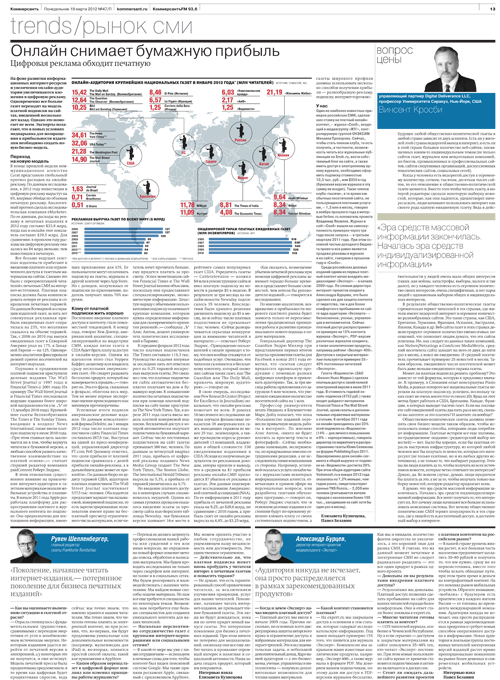
Kommersant of Moscow interviews Vin Crosbie about the future of the world’s printed newspaper industry . (Google English translation)
For the past four years, I’ve been teaching a New Media Business for media course at Syracuse University’s S.I. Newhouse School of Public Communications. It was originally open just to postgraduate students, but a few years ago we opened it to select…
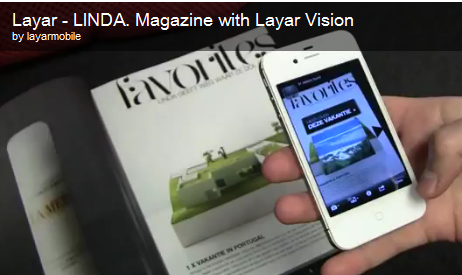
We’re generally not a company that emphasizes a continuing role for paper (as opposed to epaper) in the future, but we are enthusiastic about some of the Augmented Reality mobile phone applications being developed by the Dutch company Layar for use with…
One of the few people whose New Media work I loyally follow is the British web publishing pioneer Danny Meadows-Klue. I first met Klue during the mid-1990s when he was online publisher of The Daily Telegraph (www.telegraph.co.uk). Since that job, he has co-founded the…

The S.I. Newhouse School of Public Communications seeks a Professor and Chair in Journalism Innovation, a new, endowed position that will help place the school on the cutting edge in teaching, scholarship and inquiry. The Chair will develop and teach new, innovative…
[34-minute PowerPoint video of keynote speech opening the fifth annual Personalize MEdia Conference (formerly Individuated Media conferences), Boulder, Colorado. June 20, 2011. How traditional media companies have gone astray by misperceiving consumers’ switch from analog to digital formats to be the greatest trend…

If you think all Europeans use the Internet the same, you’re wrong. As an American who’s worked a fair amount in Europe, I love studying the variations in among how the various European nationalities use the Internet. Lately, I’ve been comparing…
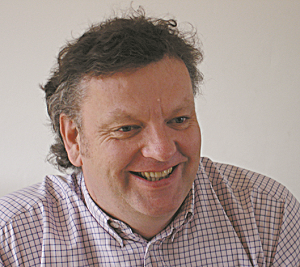
Jim Chisholm, the world’s expert about newspaper operations, tells why newspapers charging for their websites are self-destructive.
How the Apple iPad makes the placebo of convergence easier for newspaper executives to swallow.
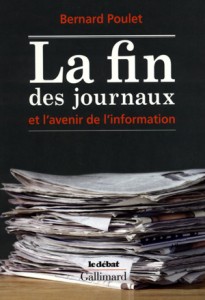
Recommending the French book, La Fin des Journaux et l’avenir de l’information (The End of Newspapers and the Future of Information).

The Verizon-Google proposal today announced for regulating Internet traffic is as good for consumers as the Axis Pact was for the world in 1940.
Several hundred media professors will converge on Denver, Colorado, this week for the annual conference of the Association for Education in Journalism and Mass Communication. I won’t be among them (I’ll be at the Mayo Clinic in Minnesota, where my fiancé is undergoing…

TV news coverage of the third annual Media Lecture, delivered by Prof. Vin Crosbie on July 14, 2010, at the Drama Center of the National Library of Singapore.

A placebo called the convergence strategy has been willingly swallowed by most media companies and the media industries.

Come to a New Media business models conference in which the Syracuse University’s Newhouse School of Public Communications is inviting only speakers who we think have the answer—regardless where they are from or what they’re rank, specialists who together have all the facets of the solution and will be working in coordination with each other at the conference.

We live amid the greatest change in the history of media. Most media executives fail to recognize it and mistake its traits as the change itself.
Nokia’s Life Tools project is an intriguing addition to news organization’s mobile palette.
What I’m teaching in the New Media Business classes at Syracuse University this semester.
Why should newspapers offer online video news? Professor Crosbie explains why to journalists from the Bosnia and Herzegovina, Montenegro, Serbia, South Africa, Russia, and the Ukraine, during the Broadcast Design workshop organized by the Media Development Loan Fund. Recorded by Televizija Vijesti in Podgorica, Republic of Montenegro, on November 21, 2008.ast Design workshop organized by the Media Development Loan Fund. Recorded by Televizija Vijesti in Podgorica, Republic of Montenegro, on November 21, 2008.
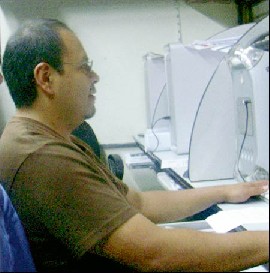
A crossbow arrow kills a newspaper layout artist, yet another attempt to silence freedom of the press in Guatemala.

Ian Alexander Davies, 49, of Topcroft, Norfolk, U.K., a husband, father of two, newspaper and magazine New Media expert, and an ardent private pilot, died Wednesday when the two-person aerobatic biplane he was aboard collided with a crop-spraying tractor as the biplane was approaching the runway at an airfield near his hometown.
My ClickZ column Friday pointed out how you would have gotten a better Return on Investment from purchasing $10,000 in beer three years ago and getting drunk each night since than you would have from investing that amount of money in U.S. newspaper company stocks.
Syracuse University’s Newhouse Schools has an opening for a Multimedia Newspaper Professor.
Why I prefer teaching New Media at Syracuse University, and what the syllabus is for my New Media Business class.
Video clip of Vin Crosbie defining the term New Media and its potential.
Why Mass Media are ‘dumbing down’, becoming more timid.
Why I’m late posting the third part of my essay ‘Transforming American Newspapers’; my plans to teach a graduate school course about Using New Media to Circumvent Censorship; and a brief thought about gPhones.
Why the major reason for American daily newspapers’ demise is their inertia has violated the basics of the Principle of Supply & Demand.
I’m back! I’d taken a year off for reflection. After concluding that no daily newspaper executive in North America knows where their industry is headed, I went back to school approximately this time last year. I’d hoped that news media academics might…
American daily newspapers are dying for only two reasons that have nothing to do with advertiser flight or with lacks of sufficient multimedia, convergence, interactivity, Web 2.0, or ‘citizen journalism. Learn the two real reasons.
Why it is imperative for newspaper companies individuate their editions in print, e-paper,and Web formats.
My opening keynote speech from EPublishing Innovations Forum 2008, London, May 7, 2008. Why 1.3 billion people have gravitate online despite their already having access to mass media in much more convenient formats than online. Why the fragmentation of audiences is an illusion. Why traditional newspapers’ and news magazines’ circulations, and news broadcasts’ viewerships, must ineluctably evaporate. Why most newspapers’ and news magazines’ and news broadcasters’ Web sites won’t save their companies. Why people will be even better served by New Media than by Mass Media. And why the change today is even greater than that during Gutenberg’s era.
At this time of fundamental challenges to media industries, are you a true leader or are you a bureaucrat hiding behind a high title?
R.I. P. Mark Schwed (1955-2008). Good Guy. Great entertainment journalist. Former colleage.
the latest repeated cutting of The Los Angeles Times’ newsroom budget confirms Ben Franklin’s definition of insanity.
American Journalism Review examines the faith and hope that American newspapers put in online publishing as the savior of the companies now that print is declining.
How Dagbladet integrates video into its website.
Asahi Shimbun’s Atsushi Sato explains how his company’s 12 sites for mobile phone users work and earn money.
“People live locally,” Ian Davies, director fo business development of the British regional newspaper publishing company Archant Ltd., this afternoon reminded attendees of Ifra‘s annual Beyond the Printed Word online pubishing conference. He said a recent survey by the (UK) Newspaper Society…
Rowan Barnett describes how his weekly newspaper has a circulation of 100,000 without publishing a website or in print.
Danny Dagan of News Group Digital (London’s The Sun and News of the World) describes the challenges popular tabloids face using with user-generated content.
At Ifra’s Beyond the Printed Word conference, Matthew Buckland of South Africa’s Mail & Guardian presents a case study of his newspapers experiments with user-generated content.
The opening keynote by German Digital Institute Director Prof. Dr. Jo Groebel at Ifra’s Beyond the Printed Word conference.
Why I’ve been absent during the past seven weeks.
I hate to rain on the parade of pundits who hail TimesSelect’s demise as proving paid content is dead. Thought payment for the traditional one-to-many package of news content, or even a subsection of it, is dead; people will be willing to pay for customized news services that exactly match from all sources each of their individual needs.
In order to survive, news organizations must stop defining themselves by products (such as ‘newspapers,’ ‘news radio stations,’ etc.) that are becoming obsolete
The New York Times Company attempts sleight-of-hand in its announcement ending its experiment at charging for online access to its Opinion section and archives.
Starting Monday, I have accepted a position as Adjunct Professor of Visual and Interactive Communications and Senior Consultant on Executive Education for New Media at the S.I. Newhouse School of Public Communications at Syracuse University and will be relocating there.
Interactivity and why hardly any news organizations’ websites offer it.